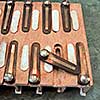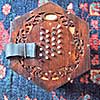The Amateur Concertinist
Robert Gaskins
Contributions to the Concertina Library by
Robert Gaskins.
-
 How to Play Chords on Any Maccann Duet Concertina
How to Play Chords on Any Maccann Duet Concertina
-
by Robert Gaskins
-
Explains how to play chords to accompany songs on Maccann Duet
concertinas of any size and from any period. Intended for beginners,
assumes no knowledge of musical notation or theory.
Includes a chord chart suitable for the lid of a concertina case. 51 pages.
-
Posted 15 February 2001
-
» read full article in pdf
-
 A Wheatstone Twelve-Sided 'Edeophone' Concertina with Pre-Maccann Chromatic Duet Fingering
A Wheatstone Twelve-Sided 'Edeophone' Concertina with Pre-Maccann Chromatic Duet Fingering
-
by Neil Wayne, Margaret Birley, and Robert Gaskins
-
A duet concertina (serial no. 35074) with a unique fingering arrangement, made by Wheatstone
in 1938, turns out to be a realization of a design from Wm. Wheatstone's patent of 1861.
The instrument is twelve-sided, a Registered Design feature of Lachenal & Co., and it
turns out to be one of at least sixteen twelve-sided instruments made by Wheatstone between
1934 and 1941. The instrument is now in the collection of the Horniman Museum, London.
As published in The Free-Reed Journal 3 (2001): 3-17.
This HTML version of the article adds a number of additional photographs and
active links to many of the sources cited in the published article.
Updated 15 August 2003: Footnote 11 updated to record that Randall C. Merris has
located instrument serial #33301, another of the set of three twelve-sided 40-key Anglos.
-
Posted 15 November 2001; last updated 15 August 2003
-
»
read full article
-
»
read original article (without updates or additions) in pdf
-
 Baffles for Maccann Duet Concertinas
Baffles for Maccann Duet Concertinas
- by Robert Gaskins
-
Explains how baffles fitted internally can reduce the volume
and/or change the tone of a Maccann Duet concertina,
and how the sound of each end can be controlled independently
so that the "balance" of an instrument can be altered.
The motivation for adding baffles is most often
to accompany a singer, to alter the sound-quality,
or to allow a right-hand melody to be heard while playing left-hand chords.
With 88 step-by-step photographs,
and web sources (UK and US) for all materials and tools needed.
15 March 2002: Updated with photos of early Wheatstone wooden baffles (from Paul Hardy)
and of Lachenal linen linings cut out individually around every button (from Joe Palof).
Also added, a photo of a unique ten-sided Maccann Duet which, rather than quieting
the left end with baffles, instead makes the right end louder by doubling all
the reeds on the right side (now owned by Neil Wayne, photo from Stephen Chambers).
15 February 2003: Updated with photos and description of very early Pre-Maccann
Wheatstone Double Duet No. 23 (1847-1848) which was equipped at the factory with conventional
baffles on both sides plus a special baffle inside the reed pan on the left side--only--to
balance the volume of the two ends.
- Posted 15 February 2002; last updated 15 February 2003
- » read full article
- » read section 1: "baffles for maccann duet concertinas"
- » read section 2: "step-by-step photographs"
- » read section 3: "appendices, where to buy materials"
-
 The Lachenal Sisters Visit Edinburgh, 1865–1866
The Lachenal Sisters Visit Edinburgh, 1865–1866
-
by Robert Gaskins
-
At Christmas of 1865–1866, three young daughters of the late Louis Lachenal gave a
series of concerts in Edinburgh introducing “concerted music” played
on treble, tenor, and bass concertinas. We think this was also exactly the period when
Lachenal & Co. had lost their contract to manufacture concertinas for Wheatstone,
making it important to publicize Lachenal’s own brand.
Based on clippings from The Scotsman newspaper, Edinburgh, notices of
concerts and reviews, October 1865 through January 1866.
-
Posted 01 February 2005
-
» read full article
-
 The Wicki System—an 1896 Precursor of the Hayden System
The Wicki System—an 1896 Precursor of the Hayden System
-
by Robert Gaskins
-
The concertina keyboard system known today as the "Hayden" system,
which was independently discovered by Brian Hayden and patented by him in 1986,
had also been discovered and patented 90 years earlier by a Swiss inventor
named Kaspar Wicki. Wicki's 1896 Swiss patent (CH13329) is clear and unambiguous, including
a keyboard diagram labeled in standard musical notation.
-
Posted 01 March 2004
-
» read full article
-
 Which Duet Concertina—Hayden or Maccann?
Which Duet Concertina—Hayden or Maccann?
-
by Robert Gaskins
-
A comparative review of two concertinas:
a Stagi Hayden Duet concertina (c. 2003),
and a Lachenal Maccann Duet concertina (c. 1900).
Each instrument has 46 keys, and each cost
£500 ($800) ready to play.
On almost every measure, the antique Lachenal Maccann Duet
turned out to be preferable to the modern Stagi Hayden Duet—by
a considerable margin. The advantages frequently mentioned as
belonging to the Hayden system (uniformity of fingering in all
key signatures, automatic transposition) turned out to be significantly
compromised by the restricted size of the Stagi. If you want to
play a duet concertina, at present you will probably do best to
buy a Maccann Duet.
-
Posted 01 March 2004
-
» read full article
-
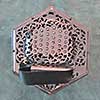 Photographs of Jeffries Maccann Duet Concertina, serial No. 6
Photographs of Jeffries Maccann Duet Concertina, serial No. 6
- by Robert Gaskins
-
Photographic documentation of a Jeffries Maccann Duet, serial No. 6, 57 keys, c. 1915.
Marked on the right with an oval engraved C. Jeffries Maker, 23 Praed St. Raised
metal ends, some construction details in common with Jeffries anglos such as linear
reed chambers. Its matching manuscript chords tutor is also reproduced on this website.
54 photographs.
- Posted 15 February 2003
- » read full article
-
 Maccann Duet Chords Tutor Manuscript
Maccann Duet Chords Tutor Manuscript
-
from Robert Gaskins
-
A polished 76-page manuscript “chords tutor” found in the
case of a matching 57-key Maccann Duet made by C. Jeffries Maker, 23 Praed St.
The instrument and the tutor are dated c. 1915. This may have been a “semi-bespoke”
tutor included with the instrument when it was originally sold.
Unlike the much later Jeffries System manuscript tutor (c. 1960) written with a biro
(ballpoint pen) in very rough style, this much-longer document was written with a split pen and
is very carefully finished.
-
Posted 15 February 2003
-
» read full document in pdf
-
 Wheatstone Anglos with Serial Numbers 50,000+
Wheatstone Anglos with Serial Numbers 50,000+
-
by Robert Gaskins
-
Between 1938 and 1974 Wheatstone & Co.
manufactured concertinas in two parallel series of serial numbers;
Englishes and Duets were given numbers #3XXXX, and Anglos were given
numbers #5XXXX. During these 37 years Wheatstone manufactured about
2,129 Englishes and Duets, with serial numbers from about #34955
through #37083, and some 9,498 Anglos, with serial numbers from #50001
through #59498. Yet, for unknown reasons, this vast population of
late Wheatstone Anglos with #50000+ numbers are not seen nearly as
often as one would expect.
The original version of this article appeared on the net at
concertina.net,
and at
Concertina FAQ.
-
Posted 23 June 2001
-
» read full article
-
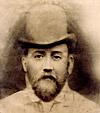 Charles Jeffries: the Man and His Family
Charles Jeffries: the Man and His Family
-
by Chris Algar, Stephen Chambers, Robert Gaskins, David Lee, Randall C. Merris, and Wes Williams
-
New information about Charles Jeffries and all of his family that participated
in the concertina making business. Contains the first known pictures of Charles
and Mary Ann Jeffries, and reproductions of birth, marriage, and death certificates
where known. Summary table of Jeffries descendants. Brief descriptions of the
addresses where Charles Jeffries lived and worked, with maps of the Praed Street area,
White Lion Passage, and the Kilburn area. Based on information from members of
the Jeffries family.
-
Posted 15 November 2005
-
» read full article
-
 The Concertina Man
The Concertina Man
-
Presented by Peter Day,
Produced by Neil Koenig
-
BBC programme on the history and music of the concertina,
focusing on its inventor Sir Charles Wheatstone as a somewhat belated
recognition of his bicentenary in 2002. In addition to the presenter, Peter Day,
the program features (in order of appearance)
Bob Gaskins, Brian Bowers, Margaret Birley, Stephen Chambers,
Frank James, Douglas Rogers, Sean Minnie, and Steve Dickinson. The program
was produced by Neil Koenig.
BBC World Service programme broadcast 07 September 2004.
-
Posted 22 November 2004
-
» read full article
-
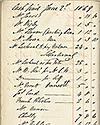 Wheatstone Concertina Ledgers
Wheatstone Concertina Ledgers
-
Directory
-
Historical business records of C. Wheatstone & Co. from
the Horniman Museum in London. Earlier ledgers from the Wayne Archives
contain company sales records from the late 1830s to the 1860s
along with production records from the 1860s to the 1890s and some
early records of wages and other payments. Later ledgers from the Dickinson Archives
contain production records from 1910 to 1974. All surviving ledgers
have been digitized (some 2,300 pages in total) and made available free on the web for
private research.
The same material is also available to buy on an inexpensive CD.
Includes an introduction to the project by Margaret Birley, Keeper of Musical Instruments at
the Horniman Museum, and an article by Robert Gaskins describing in detail how the ledgers
were digitized.
-
Posted 15 June 2003; Updated 15 June 2005
-
» go to directory
-
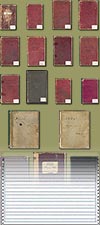 Serial Number and Date Indexes to the Wheatstone Ledgers
Serial Number and Date Indexes to the Wheatstone Ledgers
-
Directory
-
Indexes listed on this page contain serial numbers and dates from
the Wheatstone Ledgers at the Horniman Museum, London.
Each item listed is a single index (either serial numbers or dates) to a single ledger.
Indexes lead to the ledger identification and page number as
a live link: click on it to see the colour photograph of the page from which the
information was taken. There is also an
automated lookup which finds all records for any single serial number
throughout all the indexed ledgers.
(Only indexes to nineteenth-century ledgers are yet completed. Additional indexes
to the twentieth-century ledgers will be listed here as they are published.)
-
Posted 15 December 2005; updated 01 February 2006
-
» go to directory
-
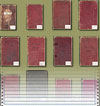 Serial Number Lookup for Wheatstone Ledgers 1830s to 1890s
Serial Number Lookup for Wheatstone Ledgers 1830s to 1890s
-
by Robert Gaskins and Wes Williams
-
A quick lookup for serial numbers in Wheatstone Ledgers covering the late 1830s to early 1890s;
type in a single number and receive a report on all its occurrences in the ledgers.
Includes ledgers C104a, C1046, C1047, C1048, C1049, C1050, C1051, C1052, C1053,
and C1054. The record for each serial number entry gives its date (if present)
and a live link to the photograph of its page in the online ledgers.
-
Posted 01 February 2006
-
» go to lookup
-
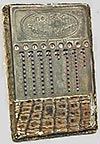 Calculate Modern Values of Historic Concertina Prices
Calculate Modern Values of Historic Concertina Prices
-
by Randall C. Merris and Robert Gaskins
-
“How much would that be in new money?”
An interactive calculator to convert sterling values from any
year 1830–1999 to the equivalent value in the year 2000.
The calculation preserves the relation between the chosen value and
“average earnings” for the two dates; this method makes it
appropriate for converting wages and capital sums, and also for
expensive discretionary products such as concertinas. The calculator deals
with both “old money” (prior to 1971) and the later decimalized
currency. It is especially useful for understanding historical documents such
as old advertisements and pricelists, and the sales prices and wages
recorded in the
Wheatstone Concertina Ledgers
from the Horniman Museum.
-
Posted 01 January 2005
-
» read full article
-
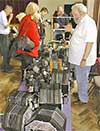 Worldwide Real-Time eBay Listings for “Concertina”
Worldwide Real-Time eBay Listings for “Concertina”
-
by Robert Gaskins
-
Latest listings from eBay sites around the world, retrieved anew
each time this webpage is loaded, linked to the eBay items.
Can be configured to perform other searches, on any one or more of the eBay national sites.
Includes listings from eBay United States, eBay United Kingdom, eBay Ireland, eBay Australia,
eBay Germany, eBay Austria, eBay Switzerland, eBay Spain, eBay France,
eBay Netherlands, eBay Italy, eBay Belgium, eBay Canada, eBay Taiwan, eBay China, and eBay India.
Auctions at eBay are generally poor
places to find playable instruments, but have unearthed much general
knowledge about ordinary concertinas and occasional museum pieces.
-
Posted 01 January 2005
-
» read full article
Do you know another resource that we should include?
Tell us about it.
Reprinted from the Concertina Library
http://www.concertina.com
© Copyright 2000– by Robert Gaskins
|

Robert Gaskins,
an amateur concertinist
|










